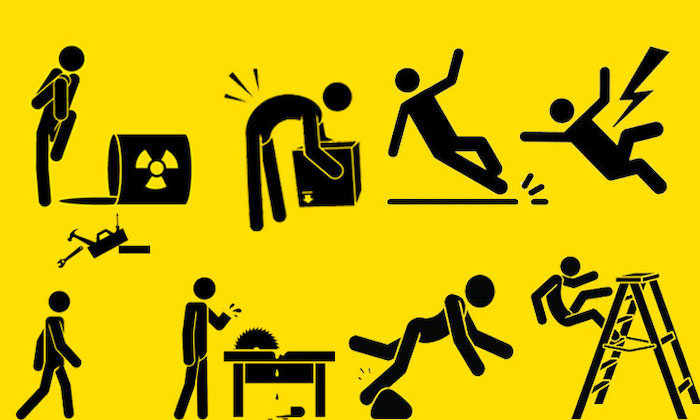
In 2019, the United States Bureau of Labor Statistics reported 2,814,000 nonfatal work-related injuries, and that was only in the private sector. Nearly one-third of these injuries were severe enough to cause time away from work.
You may think you work in a safe environment and don’t need to worry about workplace injuries. However, the fact is that work-related injuries happen in every type of job.
One of the best ways to prevent workplace injuries is to stay aware of the most common potential hazards and take steps to avoid them. The injuries that frequently occur on the job are placed into three categories, overexertion, slips and falls, and struck-by and caught-between.
Nearly one-third of all workplace injuries occur as a result of overexertion. The second most common type of injury, slips, and falls, accounts for nearly 28%. And 26% of work-related injuries are caused by struck-by and caught-between accidents.
Overuse Injuries
Overuse injuries develop gradually as you repeatedly perform the same movement. As a result, small tears develop in muscles, tendons, and ligaments and tiny cracks appear in bones.
These injuries get progressively worse the longer you repeat the same movement without resting your body or getting treatment. Before long, a micro tear causes inflammation and turns into a complete tear or you end up with a stress fracture.
Many workers develop nerve problems due to overuse injuries. For example, carpal tunnel syndrome is a common problem.
Overuse injuries occur due to:
- Overexertion
- Repeating the same movements
- Having poor posture and ergonomics
- Holding the same posture for a long time
- Using improper body mechanics when lifting
- Holding heavy or vibrating tools for a long time
Overexertion refers to exceeding your physical strength. You could overexert yourself by carrying, lifting, or pushing objects.
Most work-related musculoskeletal injuries are caused by overuse and overexertion. Though accidents happen, often causing fractures and ruptured soft tissues, sprains and strains are the leading workplace injury. When you pull a muscle on the job, you’re most likely to injure your back.
It’s important to receive training in ergonomics, follow that training, and ensure your work environment minimizes the risk of overuse injuries. You should also take occasional breaks from repetitive or stressful activities and wear braces or other protective gear as necessary.
Slip, Trip, And Fall Injuries
These injuries occur in every type of work environment. If you work in an office, you could slip and fall because of a wet floor, electrical cords, low lighting, uneven flooring, and obstacles like a box or chair in your path.
If you’re in construction or manufacturing, you may also face the risk of falling from a high place and tripping over tools or debris. In all environments, distracted walking, or walking while looking at your smartphone or the latest report, also poses a risk.
Tips to prevent slips, trips, and falls include:
- Stay aware of your surroundings
- Don’t leave clutter in hallways or where others walk
- Implement the safety measures for your work environment
- Wear and use the proper gear (fall-arrest equipment, hardhat, shoes, etc)
- Don’t read or use electronics while walking
- Close drawers and file cabinets
- Don’t carry or push anything that blocks your view
Though your employer is responsible for maintaining a safe work environment, everyone can help by reporting maintenance issues.
Struck-By and Caught-Between Injuries
These injuries occur when you’re hit by a falling object or moving vehicle, or you get caught between a fixed object and a moving vehicle. Staying aware of your surroundings — especially if you’re near scaffolding or heavy equipment — and wearing a hard hat and high-visibility clothing can help prevent these injuries.
Each type of job requires different steps to prevent struck-by and caught-between injuries. For example, you may need to carefully secure tools, stack materials to stop them from falling or make sure you don’t exceed a vehicle’s rated load or lift capacity.
No matter what type of work-related injury you have, pain management centers offer many advanced therapies, including regenerative medicine and interventional procedures that effectively relieve your pain and accelerate healing.
Precision Pain Care and Rehabilitation has two convenient locations in Richmond Hill – Queens and New Hyde Park – Long Island. Call the Queens office at (718) 215-1888, or (516) 419-4480 for the Long Island office, to arrange an appointment with our Interventional Pain Management Specialist, Dr. Jeffrey Chacko.













